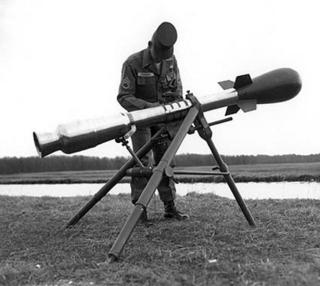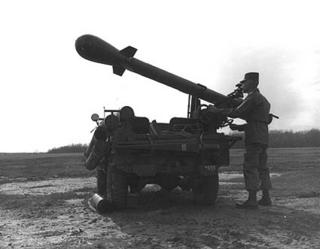Davy Crockett.
This is coolbert:
Ever since the advent of the nuclear age, and the adoption of atomic weaponry by the militaries of the world, the accidental use of an atomic bomb has always been a concern.
And a lot of measures were taken to eliminate the possibility, to the greatest extent possible, of atomic weapons being used when not intended.
We have all seen the movies where captain of the U.S. submarine receives the "go" code to use his nuclear weapons. How the three most senior officers of the sub must authenticate the "go" code, use separate keys to activate "release" systems, etc. Measures designed to eliminate the possibility of accidental and unintended use of "nukes". This always makes for drama.
During the 1960's one particular U.S. atomic weapons system was of grave concern to U.S. nuclear war planners.
This was the Davy Crockett. A very unusual atomic weapon. Reputed to be the smallest atomic bomb developed by the U.S. designers. Looks sort of like a large football.

"The W54 warhead used on the Davy Crockett weighed just 51 pounds and was the smallest and lightest fission bomb (implosion type) ever deployed by the United States, with a variable explosive yield of 0.01 kilotons (equivalent to 10 tons of TNT, or two to four times as powerful as the ammonium nitrate bomb which destroyed the Alfred P. Murrah federal building in Oklahoma City on April 19, 1995), or 0.02 kilotons-1 kiloton."
Mounted on the end of a recoilless rifle. That rifle in turn was either placed upon an Army jeep for transport [nowadays would be the "hummer"!!], or could be set up to mount upon a tripod resting on the ground.

The range of the Davy Crockett was very limited, about one to two kilometers at best. This was a low yield atomic bomb intended to be fired at a massed formation of Soviet tanks or a massed formation of "charging" Soviet troops. Gave the commander on the ground at a very low echelon of command a nuclear capability.
[I am not sure what danger there would be to the team firing the weapon? They might be killed by the weapon themselves!! As the range was so short, presumably they would have to take some sort of cover before firing so as not to be killed!!]
Therein was the problem with the Davy Crockett. There was not a lot of control over this weapons system, if and when it was deployed to the field. A team of troops commanded by a Staff Sergeant [E-6] operated the weapon. The final "go" command to fire the weapon would be given by a relatively low ranking sergeant!! This is NOT what U.S. atomic planners had in mind!!
During the Cold War, in the 1960's, about 1000 of the Davey Crockett systems were deployed to the field. What controls actually existed over the various teams so that they could NOT independently fire their atomic weapons is not known to me.
It is a fact that the Davy Crocketts did NOT have a long life in the atomic inventory of the U.S. Lasted about ten years and that was that. Better ways of delivering atomic weapons with better controls were developed. Risk was minimized to the greatest extent possible. As soon as possible, the Davey Crocketts WERE taken out of the inventory and mothballed. Possibly by now all those atomic warheads have been dismantled and the fissionable material recycled. So much the better.
U.S. nuclear planners must have breathed a sigh of relief when the Davy Crocketts were retired!!
coolbert.

0 Comments:
Post a Comment
Subscribe to Post Comments [Atom]
<< Home